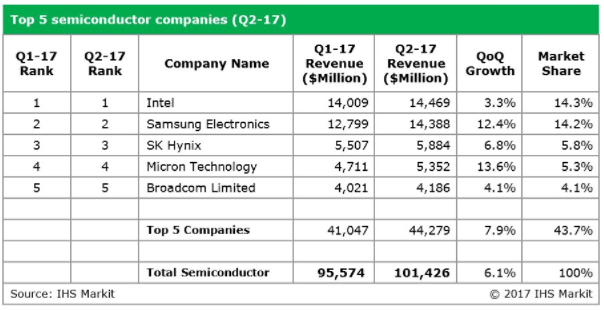
© adam121 dreamstime.com
Analysis |
Semi Industry records best second quarter in three years
Despite a slightly down first quarter, the semiconductor industry achieved near record growth in the second quarter of 2017, posting a 6.1 percent growth from the previous quarter, according to IHS Markit.
Global revenue came in at USD 101.4 billion, up from USD 95.6 billion in the first quarter of 2017. This is the highest growth the industry has seen in the second quarter since 2014.
The memory chip market set records in the second quarter, growing 10.7 percent to a new high of USD 30.2 billion with DRAM and NOR flash memory leading the charge, growing 14 percent and 12.3 percent quarter-on-quarter, respectively.
“The DRAM market had another quarter of record revenues on the strength of higher prices and growth in shipments,” said Mike Howard, director for DRAM memory and storage at IHS Markit. “Anxiety about product availability in the previous third and fourth quarters weighed on the industry. This led many DRAM buyers to build inventory -- putting additional pressure on the already tight market. This year is shaping up to smash all DRAM revenue records and will easily pass the USD 60 billion mark.”
“For NOR, the supply-demand balance has tightened raising average selling prices and revenue,” said Clifford Leimbach, senior analyst for memory and storage at IHS Markit. “This mature memory technology has been in a steady decline for many years, but some market suppliers are reducing supply or leaving the market, which has tightened supply recently, resulting in the increase of revenue.”
In terms of application, consumer electronics and data processing saw the most growth, increasing in revenue by 7.9 percent and 6.8 percent, respectively, quarter-on-quarter. A lot of this growth can be attributed to the continual growth in memory pricing, as supply still remains tight.
Industrial semiconductors showed the third highest growth rate at 6.4 percent during the same period. This growth can be attributable to multiple segments, such as commercial and military avionics, digital signage, network video surveillance, HVAC, smart meters, traction, PV inverters, LED lighting and medical electronics including cardiac equipment, hearing aids and imaging systems.
Another trend in the industrial market is increasing factory automation, which alone is driving growth for discrete power transistors, thyristors, rectifiers and power diodes. The market for these devices is expected to reach USD 8 billion in 2021, up from USD 5.7 billion in 2015.
Intel remains the number one semiconductor supplier in the world, followed by Samsung Electronics by a slight margin. IHS Markit does not include foundry operations and other non-semiconductor revenue in the semiconductor market rankings.
 Among the top 20 semiconductor suppliers, Advanced Micro Devices (AMD) and nVidia achieved the highest revenue growth quarter over quarter by 24.7 percent and 14.6 percent, respectively. There was no market share movement in the top 10 semiconductor suppliers. However, seven of the 10 companies in the 11to 20 market share slots did change market share.
Among the top 20 semiconductor suppliers, Advanced Micro Devices (AMD) and nVidia achieved the highest revenue growth quarter over quarter by 24.7 percent and 14.6 percent, respectively. There was no market share movement in the top 10 semiconductor suppliers. However, seven of the 10 companies in the 11to 20 market share slots did change market share.
images: © IHS Markit
 Among the top 20 semiconductor suppliers, Advanced Micro Devices (AMD) and nVidia achieved the highest revenue growth quarter over quarter by 24.7 percent and 14.6 percent, respectively. There was no market share movement in the top 10 semiconductor suppliers. However, seven of the 10 companies in the 11to 20 market share slots did change market share.
Among the top 20 semiconductor suppliers, Advanced Micro Devices (AMD) and nVidia achieved the highest revenue growth quarter over quarter by 24.7 percent and 14.6 percent, respectively. There was no market share movement in the top 10 semiconductor suppliers. However, seven of the 10 companies in the 11to 20 market share slots did change market share. images: © IHS Markit




